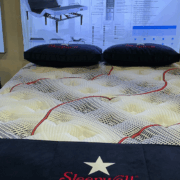The latest forecast from the International Sleep Products Association now predicts a down year for the industry in 2025.
A recent article in a trade press publication states that ISPA research shows mattress and foundation unit shipments dropped to 25.9 million in 2024, a year-over-year decline of 6.4%.
But there may be more to the story.
Jim Nation, vice president of sales for South Bay International, says he disagrees with the ISPA sales report.
“Over time, the ISPA report has become less accurate,” he says. “As the e-commerce platforms and direct-to-consumer brands have gained significant momentum in the marketplace, ISPA has not been able to track their suppliers. The ISPA sample of manufacturers is not large enough.”
And Nation is not alone in his thinking.
“While ISPA reports a downturn of ~7%–8% in total mattress shipments (to ~36–40 million units in 2023–2024), that figure likely omits a sizable chunk of online and DTC channels — where growth has been estimated at 25%–50% annually,” explains Eugene Alletto, CEO of Bedgear. “If digital sales, now a projected 25%+ of the market, are included, the true unit volume may be closer to 48–52 million annually, suggesting the total market has remained stable or even grown slightly. In short, ISPA’s decline reflects traditional channels — it does not represent the full U.S. mattress market.”
However, Gerry Borreggine, CEO of Therapedic International, says the overall industry was down in 2024 and the ISPA numbers are a decent barometer of that.
“Smaller brands, like Therapedic, have a tendency to do better in down markets,” he says. “Retailers view us as an alternative, and dealers look for alternatives when their current mix is not working. So it’s conceivable that while we had a small uptick, the overall industry suffered a modest decline.”
Looking beyond the ISPA numbers, the opportunity for independent retailers is an idea many manufacturers are optimistic about.
“Our independent dealers, the core of our business, are doing well even in these difficult times,” says Gold Bond Mattress CEO Bob Naboicheck. “They are merchandising their floors with unique and different product, and by choosing to work with a brand like Gold Bond, they are opting for quality, value, service and higher margins. We know our niche with independent dealers is unique, but we think this segment of the industry is actually holding its own. Of course, retail is challenging, but quality dealers with a strong legacy and customer base can certainly find ways to succeed even in difficult times like these.”
Mike Juoni, senior vice president of sales for Diamond Mattress, says some of the closures and filings in the industry over the past year indicate to him that there has been a contraction in the category and the ISPA numbers are accurate, even if only directionally.
“There are many retailers finding ways to win under the same conditions by embracing what makes them different, continuing to improve their overall consumer experience, and offering products that are unique in their market with real consumer value,” he says. “Those of us on the manufacturing side who are growing despite the market conditions are focused on supporting those retailers with differentiated products with meaningful stories, along with stable and predictable service and support.”
While some saythat ISPA research may be somewhat accurate, others disagree. It appears there is more to ISPA research than meets the eye.




